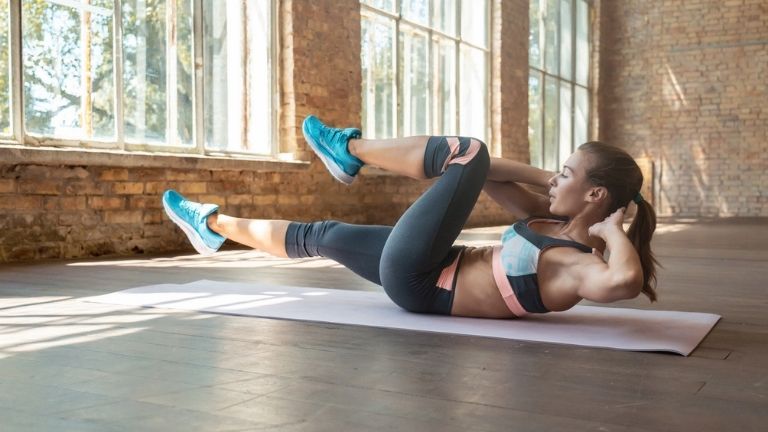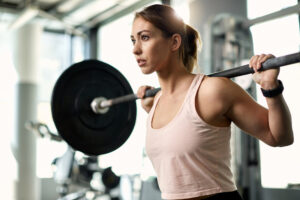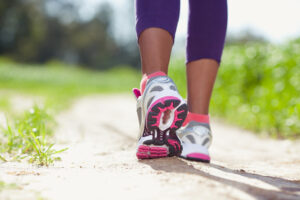Can menstrual cycle hormone changes impact exercise and training? Dr. Sayyada Mawji, GP and brand ambassador for Freeletics explains how to sync your training to your menstrual cycle
What should and shouldn’t we be doing when it comes to exercise and the menstrual cycle?
How can hormone changes impact exercise and training, and how can we use this knowledge to finesse our training routine?
There are so many questions and myths out there when it comes to periods and exercise, which is why Healthista spoke to Dr. Sayyada Mawji who explains everything we need to know.
But first, there’s only one place to start…
Let’s get back to basics: Understanding the menstrual cycle
The first step is to understand the menstrual cycle and what exactly happens during the different stages.
The length of the menstrual cycle can vary but on average it is between 21 to 35 days, day one being the start of your period and the cycle ending when the next period starts.
The first half of the menstrual cycle is called the follicular phase.
This phase starts with the lining of the uterus (womb) being shed (a period), during this time the main hormones connected with the menstrual cycle oestrogen and progesterone are low.
The length of the menstrual cycle can vary but on average it is between 21 to 35 days
After the period (when bleeding stops) around day five to eight the oestrogen levels start to rise, the lining of the womb builds up again and the oestrogen levels peak around mid-cycle which leads to ovulation (release of an egg).
The second half of the menstrual cycle is known as the luteal phase.
During this phase the oestrogen levels remain high and progesterone also rises, this keeps the uterus lining thick (preparing the body for a possible pregnancy).
When the egg is not fertilised, both hormone levels drop, the uterus lining breaks down, and your period starts again (the cycle re-starts).
How do menstrual hormones (oestrogen and progesterone) affect your body?
As well as being hormones of menstruation and reproduction, oestrogen and progesterone also affect the functioning of other organs such as the brain, the heart, muscles and bones.
Oestrogen helps to maintain bone density and is essential for healthy bones. It is also known to be anabolic – increasing muscle mass and strength.
Research studies show that strength training during the follicular phase results in increased muscle strength compared to strength training in the luteal phase.
changes to oestrogen and progesterone levels can cause premenstrual symptoms
One study found that the maximal voluntary contraction, which measures muscle strength, was significantly greater in the early follicular phase compared to the late luteal phase.
However, in tendons and ligaments high levels of oestrogen can cause increased laxity, with research suggesting a higher risk of injury.
In the brain, oestrogen increases the levels of the serotonin chemical, boosting mood and energy levels.
In the second half of the menstrual cycle, changes to oestrogen and progesterone levels can cause premenstrual symptoms such as mood changes, feeling bloated, and breast tenderness. Progesterone also leads to a rise in core body temperature.
How can we use the menstrual cycle to optimise our exercise and training?
Understanding how these hormones work, their effect on different systems and how they change throughout the menstrual cycle, we can understand how training and exercise are impacted, allowing women to optimise and tailor their exercise regimen.
To do this, let’s break down the cycle week by week to see how we can optimise training (using the average 28 day cycle as a template).
Week One
Both hormones levels are low. Oestrogen gradually starts to rise and you might find that it becomes easier to get active during this time.
Now would also be the ideal time to get in some strength training, as per the emerging research on the impact of oestrogen on muscle strength.
If you’re new to strength training, or not quite sure where to start, fitness app Freeletics offers a wide range of Training Journeys which are suited to your goals and fitness ability.
Week Two
As we enter week two, the oestrogen levels peak before ovulation and you might find that your energy levels go up during the week.
Take advantage of the positive effects on your mood and motivation as oestrogen levels increase and get training.
Remember to have a good warm-up and exercise safely, as oestrogen can make ligaments and tendons more lax during this time.
Week Three
After ovulation in this week, progesterone begins to rise, and this can make you feel more tired or sluggish.
Exercising at this time can give you more energy and boost your mood, but because of the changes, consider switching to more low-intensity training or long walks – and take rest days.
Week Four
In this week you may start to experience some premenstrual symptoms (PMS) as oestrogen and progesterone levels begin to fall.
Research shows that those who exercise regularly have fewer painful cramps during menstruation too.
During this week moderate-intensity physical activity, like yoga, can help with these symptoms and keep energy levels up.
Take away: know your cycle and listen to your body
Whilst the above is a useful guide to help tailor your training and exercise, there is more research to be done to understand this area further.
Whilst research exists to guide us, there are limitations to the conclusions we can draw because of the small participant numbers of the studies.
the most important thing is to listen to your body
However, there are steps we can all take to understand the relationship between our cycles and exercise. The first step is to know your own cycle.
Start by tracking your menstrual cycle in a journal or by using an app (there are so many cycle tracking apps!).
Write down the different symptoms you experience and how you feel at different parts of the cycle, noting down your energy levels, mood, any fatigue and PMS symptoms, as well as how you feel during exercise and training.
By using the information above, you will be able to structure an exercise regimen that works for you.
Of course, the most important thing is to listen to your body, and if you notice any irregularity or changes to your menstrual cycle it’s worth speaking to your doctor.
Dr. Sayyada Mawji, GP and brand ambassador for leading AI-based fitness and lifestyle coaching app Freeletics
More Healthista Content:
Dancing On Ice legend reveals 5 reasons figure skaters are in such great shape
5 ways to feel awake and alert EVERY morning
7 osteopath recommended morning stretches to set you up for the day
Foodie Friday: roast salmon, avocado & puy lentil salad
A gynaecologist’s guide to heavy and irregular bleeding
Like this article? Sign up to our newsletter to get more articles like this delivered straight to your inbox.


























































